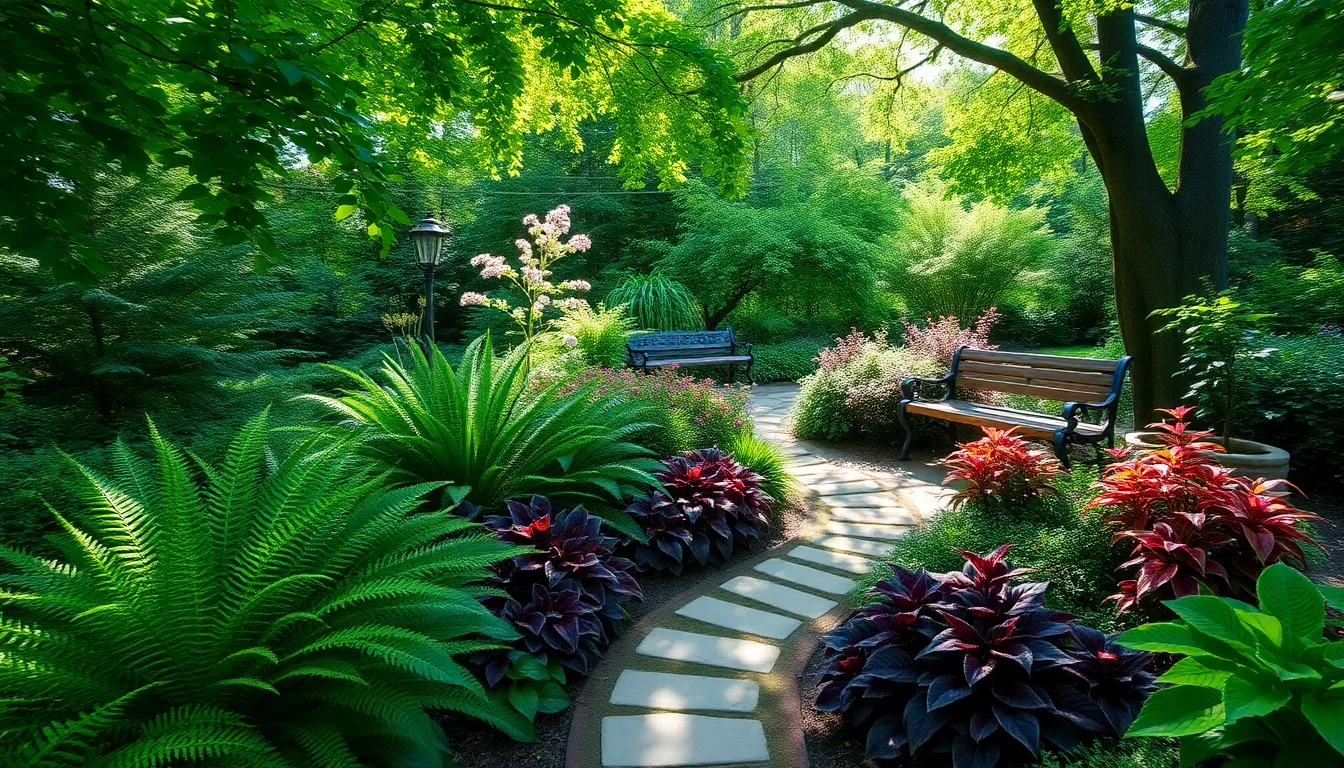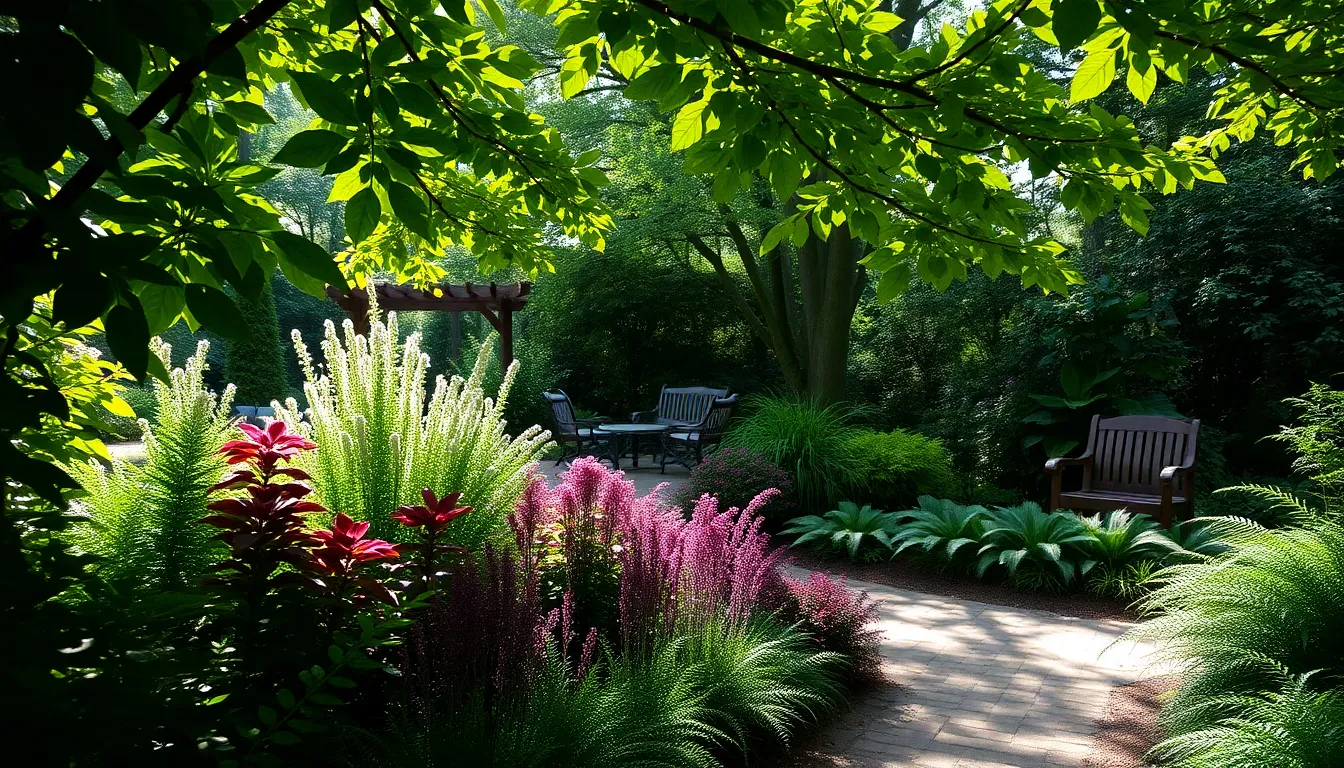When life hands you a shady spot in the yard, don’t fret—embrace it! A shade garden can be the ultimate sanctuary, turning those dimly lit corners into vibrant havens. Imagine lush foliage, colorful blooms, and a delightful retreat where you can sip your morning coffee without the sun blinding you like a deer in headlights.
Table of Contents
ToggleWhat Is a Shade Garden?
A shade garden consists of plants that thrive in low-light conditions, showcasing greenery and blooms in areas shielded from direct sunlight. Such gardens provide an ideal environment for various plant species, enhancing the beauty and functionality of often overlooked spaces.
Typically, shade is caused by trees, buildings, or fences, creating a unique microclimate. These areas may expose certain sections to filtered light or dappled sunlight, while others remain in full shade, allowing for diverse planting options.
Selecting the right plants is crucial. Heucheras, hostas, and ferns often flourish in shade gardens, offering different textures and colors. Diverse colors can be found in the blossoms of astilbe, while Japanese maples bring stunning foliage.
Incorporating hardscape elements like paths or seating areas can enhance function and aesthetics. Pathways made of stones or mulch can define spaces and improve accessibility. Seating areas invite relaxation, creating a serene escape from brighter surroundings.
Maintenance entails regular watering, mulching, and pruning. These actions support healthier plants and prevent disease. Understanding plant needs ensures long-lasting beauty and vibrancy within a shade garden.
Ultimately, shade gardens transform dim areas into lush retreats. They provide creative Opportunities for gardeners to explore plant diversity while enjoying serene environments year-round.
Benefits of a Shade Garden

Creating a shade garden offers multiple advantages that make these spaces more enjoyable and functional.
Enhanced Aesthetic Appeal
A shade garden can showcase a vibrant range of colors and textures. Selecting plants like ferns, hostas, and heucheras adds depth to the landscape. Lush green foliage juxtaposed with colorful blooms creates visual interest. The variety of shapes among plant leaves introduces unique design elements. Using contrasting textures enhances the overall beauty, making shaded areas feel alive. Incorporating hardscape features such as benches and paths adds an inviting touch, encouraging relaxation. With careful planning, a shade garden becomes a stunning focal point in any yard.
Improved Microclimate
A well-designed shade garden contributes to a more favorable microclimate. Reduced temperatures in shaded areas offer comfort during hot summer months. Lower sunlight exposure helps retain soil moisture, minimizing watering requirements. This environment promotes plant health, allowing them to thrive without the stress of direct sunlight. By creating a barrier against wind, shade gardens provide shelter for delicate plants. Furthermore, these gardens support beneficial wildlife, including birds and pollinators. Overall, the microclimate in a shade garden can encourage a flourishing ecosystem.
Ideal Plants for Shade Gardens
Selecting suitable plants is key for creating a thriving shade garden. Growers can choose from a variety of perennials and shrubs that thrive in low-light conditions.
Perennials for Shade
Heucheras offer vibrant foliage that ranges from deep purple to bright lime, enhancing visual interest. Hostas, known for their large leaves, provide excellent ground cover and come in many shades of green. Ferns, such as the lady fern or Japanese painted fern, add delicate textures and a lush appearance. Astilbe, with its plume-like flowers, blooms in various colors, including pink and white. Together, these perennials create a striking contrast, bringing life to shaded areas throughout the seasons.
Shrubs and Trees
Azaleas contribute stunning floral displays in spring, enriching shade gardens with their vibrant colors. Japanese maples, valued for their graceful branches and beautiful foliage, serve as focal points. Boxwoods, easily shaped into hedges, deliver structure and year-round greenery. Sweet viburnum offers fragrant blooms and berries that attract wildlife. Each of these plants adds unique characteristics, making shade gardens more interesting and diverse.
Designing a Shade Garden
Designing a shade garden involves careful consideration of various elements to create a harmonious and inviting space. The following areas focus on layout planning and selecting the right location.
Layout and Planning
Effective layout plays a crucial role in establishing a successful shade garden. Start by mapping the garden area, considering existing structures like trees and fences. Utilize curved pathways to encourage exploration, while creating distinct zones for sitting, planting, and walking. Group plants with similar light needs together to enhance growth and visual appeal. Incorporate larger plants as focal points, surrounded by lower-growing varieties to create depth. Plan for seasonal interest by selecting plants with varied bloom times and foliage colors. Additionally, make space for hardscape features that offer resting spots and enhance accessibility throughout the garden.
Choosing the Right Location
Selecting the right location is vital for a flourishing shade garden. Identify areas that receive dappled sunlight or partial shade, as these environments support a diverse range of plants. Observe how sunlight shifts across the space throughout the day, noting the durations of shade each section receives. Avoid spots with excessive darkness, as they may hinder plant growth. Consider proximity to water sources, ensuring easy access for irrigation. Evaluate soil conditions, as well-draining soil promotes healthy root development. Ultimately, the chosen location should balance aesthetic values with practical gardening requirements, ensuring the long-term success of the garden.
Maintenance Tips for Shade Gardens
Regular watering promotes healthy growth in shade gardens. Ensuring the plants receive adequate moisture, especially during dry spells, encourages vibrant foliage. Utilize mulch to retain soil moisture and suppress weeds. A 2 to 3-inch layer of organic mulch around the base of plants provides essential insulation and enhances soil quality.
Pruning plays a vital role in maintaining the shape and health of plants. Trimming back perennials after flowering encourages new growth. Removing dead or damaged branches from shrubs and trees improves airflow and reduces the risk of disease. Inspecting plants regularly helps identify issues early, allowing for timely interventions.
Fertilizing supports lush growth in shade gardens. Using a slow-release fertilizer in early spring supplies essential nutrients. It’s beneficial to follow specific recommendations for each plant type, as different flora may have unique requirements. Testing soil for nutrient levels can guide appropriate fertilization strategies.
Controlling pests naturally proves effective in these garden environments. Encouraging beneficial insects like ladybugs can manage aphid populations. Handpicking larger pests, such as caterpillars, prevents damage while maintaining an eco-friendly approach.
Planning seasonal activities is crucial for optimal maintenance. Winter care, such as protecting sensitive plants, ensures their survival. Spring tasks include tidying up fallen leaves and dead foliage, preparing the garden for new growth.
Incorporating companion planting can enhance biodiversity. Grouping compatible plants together promotes a productive ecosystem. Collaborating with native plant species encourages wildlife attraction, enriching the overall garden experience. By prioritizing these maintenance practices, gardeners cultivate thriving shade gardens that remain beautiful and vibrant throughout the year.
Embracing the beauty of shade gardens opens up a world of possibilities for any gardener. These serene spaces not only enhance the landscape but also provide a peaceful retreat from the sun. By carefully selecting plants that thrive in low light and incorporating thoughtful design elements, anyone can create a vibrant and inviting environment.
With proper maintenance and attention to detail, shade gardens can flourish throughout the seasons, offering a delightful mix of colors and textures. Ultimately, these gardens serve as a testament to the beauty that can be found in the most unexpected places, inviting both relaxation and appreciation of nature’s diversity.



